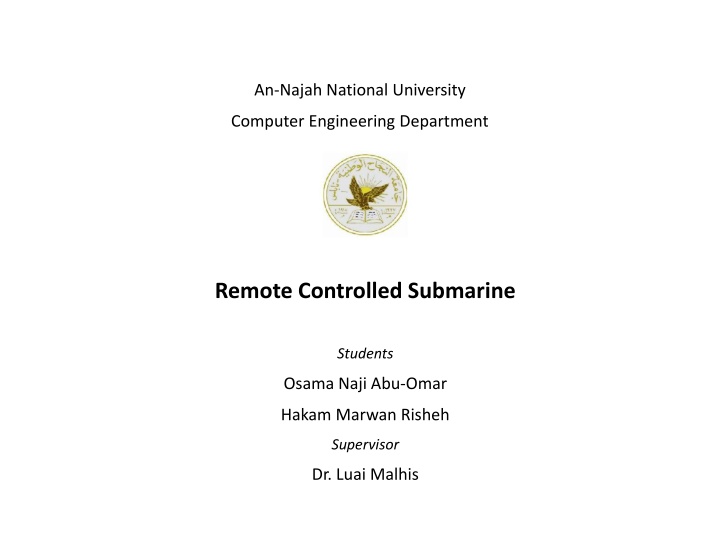
Innovative Remote Controlled Submarine Project at An-Najah National University
"Explore the fascinating project by Computer Engineering students at An-Najah National University, involving a small remote-controlled submarine designed for entertainment and underwater games. Learn about the project idea, body design, motor drivers, wireless communication, and the use of Arduino Uno R3. See how the team implemented considerations for size, balance, and motor control. Discover the selection of the L298N motor driver and wireless control via Bluetooth for short-distance communication. Dive into the block diagram and witness the creativity of the students in this exciting endeavor."
Uploaded on | 1 Views
Download Presentation

Please find below an Image/Link to download the presentation.
The content on the website is provided AS IS for your information and personal use only. It may not be sold, licensed, or shared on other websites without obtaining consent from the author. If you encounter any issues during the download, it is possible that the publisher has removed the file from their server.
You are allowed to download the files provided on this website for personal or commercial use, subject to the condition that they are used lawfully. All files are the property of their respective owners.
The content on the website is provided AS IS for your information and personal use only. It may not be sold, licensed, or shared on other websites without obtaining consent from the author.
E N D
Presentation Transcript
An-Najah National University Computer Engineering Department Remote Controlled Submarine Students Osama Naji Abu-Omar Hakam Marwan Risheh Supervisor Dr. Luai Malhis
Overview Project idea Body design Drivers and Wireless communication The microcontroller The remote Non-stationary water mode Demo Conclusions and future work
Project idea Small remote controlled submarine Mainly built as an entertaining project for mini games underwater Can moves in three dimensions Controlled via a wireless connection Can Hold Position in non-stationary water
Body Design Initial submarine body:
Considerations taken: Size fits the components Light enough for motors Balanced in water (horizontal position) Directional motors give enough torque Protection from hitting the propellers
Motor drivers Free / stall motor current draw: Motor rating Free (no load) mA Stall (stopped) mA M1 (Forward) 220 1300 M2 250 1500 M3 (Up/ Down) 750 1700 M4 (Left/ Right) 50 500 M5 350 1200
Choosing the Driver The L298N dual h-bridge motor driver was chosen Can supply up to 4 amps of current Control in both directions Speed control using PWM
Wireless Control Controller communicates via Bluetooth fits the requirements of the project Short distance controlling Easy to implement (less time) BT module is available and relatively cheap Control using an application (any phone)
The Microcontroller Arduino Uno R3
Command Messages UI Command up arrow Up arrow Down arrow Down arrow Left arrow Left arrow Right arrow Right arrow D D S S ON OFF H H event Press Release Press Release Press Release Press Release Press Release Press Release Click toggle 1 Click toggle 2 Click toggle 1 Click toggle 2 String command F,1,SPEED F,0,SPEED B,1,SPEED B,0,SPEED R,1 R,0 L,1 L,0 D,1,DSPEED D,0,DSPEED S,1,DSPEED S,0,DSPEED O,1 O,0 H,1 H,0 Notes Thrust speed Thrust speed Thrust speed Thrust speed No speed No speed No speed No speed Diving speed Diving speed Diving speed Diving speed On/off On/off Hold or Auto Hold or Auto
The Remote We Build an Android application as a remote control for the submarine.
Non-stationary water mode Submarine gets HOLD POSITION command Water streams push the body Accelerations (forces) are detected The submarine responds by pushing to the opposite direction of the water stream Returns to it s initial position
Non-stationary water mode We used an Accelerometer sensor It detects Accelerations applied to the submarine The ADXL335 3-axis accelerometer
Enhancements Custom body, better material Custom remote control, radio frequency operation (more range) Brushless Motors Smaller components (smaller whole size) Special water propellers
Future work Grabber arm (for other types of games) Auto obstacle avoidance (protection from crashes) Hooking up other sensors, an off line camera. Think of others ?...
Conclusion Submarine operation in static water tested and worked as expected with acceptable results. Accelerometer is barely accurate enough to detect water streams in water in the final testing stage, water (moisture) leaked into the components and some damaged, due to poor isolation.






















